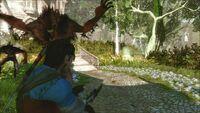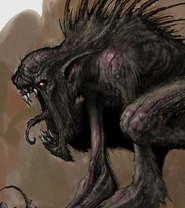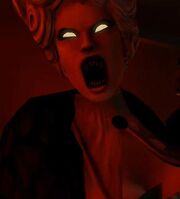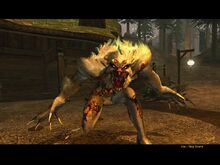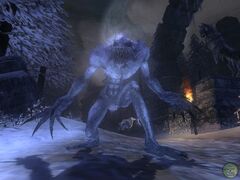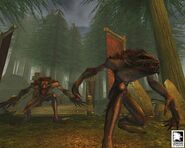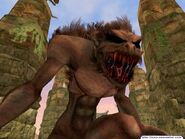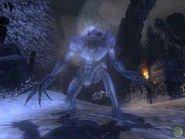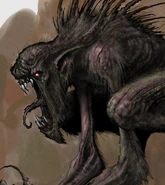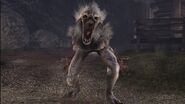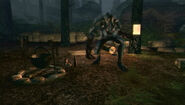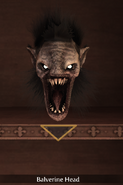This page falls under the scope of the Anniversary Update Project.
|
| Attention: Novel Content This article or section contains information original to the novel Fable: The Balverine Order, which is a licensed Fable work, but does not necessarily conform to Lionhead's Fable canon. |
| Warning: Spoilers This section or article may contain spoilers! |
| “ | If you don't buy my goods, balverines will eat your children! No, really, I've seen it happen! — Female Merchant in Fable III |
” |
A balverine is a werewolf-like enemy that has appeared in every Fable game to date.
History
According to the Oracle of Snowspire, the balverine was descended from a terrible creature called the Balvorn which was far more vile and savage than a balverine. It feasted upon thousands of humans at a time. There was only one man who survived its attacks, and that man became the first balverine.
Citizens of Albion are afraid of these beasts, and with good reason: balverines can infect others, turning them into balverines through a bite. Perhaps because of their terrifying qualities, some have been captured and put into venues like the Arena and Crucible for gladiatorial purposes. Their natural aggressive tendencies make them perfect opponents of Heroes in the battlefield. It is said that when a man gets bitten by a balverine during the full moon, they become the much more powerful White Balverines, which were slain in the Old Kingdom through the use of silver weapons.
Template:Canonicity Following the ascent of a Hero to the throne of Albion, the population of balverines was driven farther east. It has been stated that the creatures were driven eastward to a land less "tamed" by the machinery and mundane innovations of man, like many other mythical races. Tales have indicated that currently the most notable population of balverines exists in the forests near Sutcliff.
Within the forests of Sutcliff, there is a large temple. The date of construction for the temple, or its exact builders, is currently unknown, however it is currently the headquarters for an organization known as the Balverine Order. The Balverine Order is a collection of highly sophisticated balverines, headed by a particularly powerful balverine known as Lugaru, who ruled over their lesser counterparts. The purpose of the order is to slowly subvert the Human race by turning its most powerful and prominent figures into members of the Balverine Order. The Order then plans to use their new stationary power to overthrow the dominance of humanity and lay waste to its civilization, thus returning the world to a more natural state that is better suited to the balverine race.
The Balverine Order was discovered by a man named Quentin Locke, who proceeded to research and hunt down the Order. Eventually, he traced the order to Sutcliff and a man named Ethan Kreel, Laird of Sutcliff. Locke suspected Kreel was a member of the Balverine Order, but could not be sure, so he infiltrated a balverine hunting expedition organized by Laird Kreel as a servant. Locke also encountered Thomas Kirkman and James Skelton, two youths looking to hunt balverines to avenge Thomas' brother's death.
During the expedition, Kreel lured the hunting party into the forest and a trap arranged by the Balverine Order. All of the servants were immediately slain and consumed by balverines except Locke, who managed to escape undetected. The more prominent individuals, including two nobles, Thomas and James, and a dean of a notable school, were captured and taken to the Balverine Temple to be transformed into balverines at midnight.
Locke, who had tracked the balverines back to the temple, rescued Thomas and James before they could be taken inside and escaped back to Sutcliff. Once in Sutcliff, they returned to the mansion of Laird Kreel, which was revealed to have formerly been a Hall of Heroes. Inside, the three discovered the final resting place of the most powerful Three Heroes in Sutcliff's history: the Hero of Will, the Hero of Skill, and the Hero of Strength. This was the tomb of the Triumvirate, a near unstoppable team of Heroes who had secured themselves and their power within the tomb to keep it protected from the forces of evil. Inside, Locke, Kirkman, and Skelton proceeded to collect the artifacts of the Triumvirate and become the Triumvirate themselves (temporarily). Using their new-found powers, the Triumvirate returned to the Temple and launched a full assault. They slaughtered many balverines (possibly hundreds), killed Lugaru himself, and rescued the captured nobility and dean.
Afterwards, at least Locke went on to hunt the remaining members of the Balverine Order. This culminated when Locke shot and killed a duke from a neighbouring country to Albion, who turned out to be a member of the Order. Locke presumed this to be the last member of the Order, however this has not been confirmed. Template:Canonicity End
Characteristics
They share certain similarities with werewolves such as a wolf-like appearance with black or brown fur and piercing yellow eyes, and a noticable vulnerability to silver (in Fable II, this is stated as superstition, but the silver nitrate lamps in Fable III prove otherwise). Balverines are also much stronger than a normal human and even rival Heroes in physical strength as displayed by their lean musculature, and unique ability to jump high into the air disappearing for several seconds before landing again. In the fourth issue of the "Bowerstone Times", it is stated that they are far less hairy than werewolves and lack snouts.
Template:Canonicity They have been shown to be capable of a level of sophistication not previously considered possible, as evidenced by the formation of the Balverine Order. There are at least two classes of balverines: the lesser balverines who are the remnants of men bitten but not killed during a balverine attack, and the greater balverines who were bitten and turned at midnight during the course of a full Moon. The higher balverines are extremely sophisticated and much more powerful than their lesser counterparts. Higher balverines can also change form at will and are capable of human speech. It is evident that the higher balverines essentially rule over their lesser cousins, whom they seem to regard as little more than beasts. Template:Canonicity End
Attacks
Balverines are able to attack with their claws as well as by leaping at their victim. They are also able to jump high into the air (completely out of sight) disappearing for several seconds before landing again, usually behind you. However, this can be countered by simply turning around when the balverine jumps. balverines tend to use short, fast combo attacks and they can also lunge at you from quite a distance. Often balverines will jump high off the screen, but before they do so they will howl for a second or so, attack them or heal yourself at that time.
Fable II
Balverines return in Fable II, and are first encountered on the road to Westcliff. They have their own dungeon, called the Howling Halls, that the player must get through to get to the Westcliff Camp. Also, they are fought in the arena known as The Crucible. During the Hero of Skill quest, while returning the Shadow Seal to its owner, you must fight several Shadows that act and fight like balverines.
While travelling along the Westcliff Road, a woman named Lilith requests your help saving her son from balverines. However, she betrays you to her "children" (balverines) for food before jumping out of sight. This indicates the ability to shape-shift and greater intelligence for the more advanced balverines, she reappears later after the Hero defeats all her "Children" as a White balverine.
Fable III
They are first encountered in Reaver's Manor, after Reaver's party guests transform and attack The Hero and Page, although it is possible to encounter them in the wild before this event if your Hero Level is high enough. They can later be encountered in Silverpines, Millfields, Mistpeak Valley and Hero of Bowerstone's Tomb They also seem to have the ability to take on human form and live in Albion amongst its population.
Once you become the ruler of Albion, you will receive a quest in which a noble wants to donate a valuable balverine statue worth 500,000 gold. However, when you arrive to claim it, you are informed that it has been stolen. In order to retrieve it, you must travel to Silverpines where there is a village under near-constant threat from balverines. When you confront the thief, he is revealed to be Connor, a villager who was exiled into the dangerous forest for falling asleep on watch. Yearning for revenge, he offers to give you the statue and let you leave unscathed if you destroy the village's silver nitrate torches, which are its only real defense against the balverines. This, however, is a good/evil decision, and if you refuse, he will order the balverines to attack and you must rush back to the village to help defend it. Once you defeat many of the balverines, Connor will arrive and transform into a white balverine and you must defeat him and claim the statue from a villager who found it on his body. If the Hero chooses to aid the balverines by destroying the torches, the village will change. New residents named "(Name) the Thug" will begin to appear, and if attacked, will show their true forms by transforming into balverines and attacking, supporting the notion that balverines have the ability to evolve and adapt.
In the Traitor's Keep DLC, balverines can be found running wild at the Godwin Estate, and many have been subjected to experimentation by the island's sole resident, Mary Godwin. As a result, they can be seen cooperating with hollow men in their attacks, and Mary has apparently been successful in creating poison balverines. They are first seen in the bowels of the mansion, just before the final confrontation with Mary, who has them submerged in tanks. They break out and attack when the Hero and Commander Milton approach. Upon return trips to Godwin Estate, poison balverines will spawn on the grounds.
Fable: The Journey
Albion's infamous monsters reappear in Fable: The Journey. First encountered in the deep forest of Thorndeep, a location similar to the Silverpines in both appearance and balverine infestation, balverines retain their infamous speed and their ability to inflict incredible damage with their claws. As in previous Fable games, balverines will charge Gabriel in groups, leaping back into the treeline to avoid any reprisals.
Types
White Balverine
White balverines are supposedly normal people who were bitten during a full moon and transformed. They are named for their distinctive white coats, and are larger and stronger than normal balverines. Thus, they often serve as leaders within balverine packs, and can summon lesser balverines at will by howling.
Fable
The white balverine is first encountered near Knothole Glade during the appropriately named quest White Balverine. The white balverine was a man who was transformed after killing a previous white balverine threatening the village. His wife mourns his loss, and helps the Hero kill the beast her husband has become. To help the Hero, the woman gives him a Silver Augmentation to take advantage of the balverines' weakness to silver.
They are also present in the Witchwood Arena.
Surprisingly, although it is said in that only weapons with Silver Augmentations can harm the white balverine, it is unnecessary to use them, although it increases your damage greatly.
Fable: A Hero's Tale
The game begins with a white balverine killing the parents of the Hero of Southcliff and attacking Giles. The balverine later appears at the Hero of Southcliff's wedding, and takes his would-be spouse to the castle on the hill for a final climatic showdown. After the Hero triumphs the white balverine, it subsequently turns into the Duke of Southcliff who begs for mercy, claiming that the curse has been broken. The Hero can chose to kill the Duke or not.
Fable II
White balverines return in Fable II. They are first encountered in Westcliff on the journey to enter the Crucible. On the way, the Hero will find a woman saying she was attacked by balverines; however, she is actually a white balverine in disguise. She will ask you to save her son that was taken by the balverines, but she will lead you into a nest of balverines in the Howling Halls. Once you have killed all the normal ones, she will call for vengeance and will come rushing to attack. As was the case in Fable, white balverines are bigger, faster, stronger, and can take much more punishment.
There are others to be found in the Crucible and The Colosseum.
Fable III
White balverines make their first appearance in the Stolen Statue quest, with the leader of the local balverine pack, a man named Connor, turning into one before leading the assault. Once again, white balverines in Fable III are superior to their more common brethren in every way. White balverines are often found in the midst of balverine packs, and will usually lead the charge.
White balverines can be found consistently in the balverine-infested forest of Silverpines. They can also be found in Mistpeak Valley once the Hero is strong enough.
Fable: The Journey
White balverines are seen once again in Fable: The Journey. Due to the change in combat compared to other Fable games, the white balverines of Fable: The Journey are not nearly as dangerous or intelligent as their brethren from other games. However, they are noticably tougher to kill, requiring more Will attacks be used against them.
Frost Balverine
Frost balverines are essentially regular balverines, but with ragged white fur (not to be confused with white balverines). Not much is known of frost balverines, except for the fact that they live in the Northern Wastes.
They are much more dangerous than the regular balverines and will deliver a bigger punch, but are weaker than white balverines. The white coat of the frost balverines could be compared to the coat of an arctic wolf, used for camouflage.
Frost balverines are found anywhere in the Northern Wastes. During the quest Oracle of Snowspire, frost balverines repeatedly spawn on bridges and narrow enclosures.
Blooded Balverine
Made distinct by their brick-red fur, blooded balverines often assume a leadership role when white balverines are not present. Blooded balverines are more powerful than standard balverines, and do not usually share their weakness to fire.
Fable II
Blooded balverines often infest the road to Westcliff. Although not as strong as the superior white balverine, blooded balverines are still dangerous foes, often slashing the Hero before quickly jumping away. However, they often let their weaker breathren attack first.
Fable III
Blooded balverines make an appearance in Fable III, often comingling in packs alongside normal balverines. They retain similar tactics to those in Fable II, but are usually present in greater numbers. In addition to being found across Mistpeak and Silverpines, one can usually find blooded balverines in the Wheel of Misfortune.
Poison Balverines
Fable II
Introduced in the Fable II DLC See the Future, poison balverines are first encountered in The Costume Party quest. Although they behave much like normal balverines, poison balverines are visually very distinct, with green-coloured fur and oftentimes emitting a green, trailing smoke. Poison balverines are most dangerous for their disorienting attacks, which result in the Hero's vision getting blurry as if drunk, making combat difficult.
Fable III
Poison balverines return en masse in the Fable III DLC Traitor's Keep, making their appearance in the quest Traitor's Keep: The Menagerie. Ambushing the Hero as they explore the gardens of the Godwin Estate, poison balverines retain their disorienting abilities. However, poison balverines change their tactics in Fable III, preferring massive swarm-attacks that can easily overwhelm a careless Hero.
Corrupted Balverines
Fable: The Journey
Like several other species throughout Fable: The Journey, balverines eventually appear that have been visibly tainted with Corruption. Glowing orange-red in appearance, these balverines are similar to their ordinary brethren in all ways except one – they are almost invulnerable to damage, largely due to the Corruption shielding them. The only way to harm these balverines is to use the "Light" power obtained from the Willstone of Sol.
Trivia
- A non-hostile balverine is found in a cage by the door entering the Arena. If you kill it, everyone will exclaim as though you killed an innocent person.
- The name "balverine" is likely taken from "wolverine", a mammal in the weasel family known for its incredible ferocity.
- The balverines' weakness to silver is a reference to werewolves' vulnerability to silver bullets.
- With information provided by Lilith, in Fable II, and Reaver's party guests, in Fable III, it can be concluded that at some point in time the balverines evolved so that they could maintain a human appearance and transform at will, rather than remain in their monster form indefinitely. This is further explained in Fable: The Balverine Order, that only humans bitten during the midnight hour during a full moon have this ability.
- In Fable II, Sister Hannah sings a song mentioning white balverines.
- Balverines are most commonly encountered in the presence of rain or at night.
- In Fable II, if you use the Will ability "Shock" on a balverine, it will show a human skeleton during the effect. Also, when you kill a balverine with Shock, a rather elongated human skeleton will remain. This supports the theory that balverines are transformed humans, much like werewolves.
- Balverines in Fable II are weaker than the ones in Fable and Fable: The Lost Chapters, possibly because they are considered common enemies now. However, their difficulty is restored in Fable III.
- Balverines will never bite the player and will only use their claws to attack, giving no opportunity for the player to become infected.
- As shown in Fable, when a person starts changing into a balverine they start acting like it, for example they would start craving human flesh.
- Also when someone does change into a balverine a red mist circles around them.
- The description of Howling Cheese seems to suggest that balverines are capable of producing milk, though how, and why, one would 'milk' a balverine are unknown.
- White balverines are known to be humans who were bitten by a balverine during a full moon, unlike regular balverines who were humans bitten at any time.
- It is mentioned by Reaver that the guests at his party were part of a secret society. This may be a reference to The Balverine Order from Fable: The Balverine Order By Peter David.
- In Fable III, balverines count as large enemies for the purposes of Legendary Weapon upgrades.
- In Fable II, balverines seem vulnerable to fire. The Will ability Inferno can kill a normal balverine quickly, and a higher level can kill several in one casting.
- It is mentioned by Reaver in Fable III that he "toyed" with the idea of becoming a balverine himself, but then he says that his pretty face was worth more.
- In the original Fable and TLC, if you stab a dead balverine, you can still hear its growl.
- In Fable III, some of the potential morphs for Hero Weapons are balverine-themed. These morphs can also be seen on legendary weapons such as Avo's Lamentation, The Barnumificator, The Hero's Companion, and the pre-order-only hammer The Champion. There is also some weapon upgrade objectives which require the killing of Wolves or Balverines such as the Lunarium Pounder, and the Limited Collector's Edition sword Wolfsbane.
- In Fable III, if the player destroys the silver nitrate torches in order to let the balverines attack the village in Silverpines, Connor will tell the Hero that they are "always welcome" in Silverpines. He seems to go back on his promise, as any balverines in the area will attack you as they did before.

